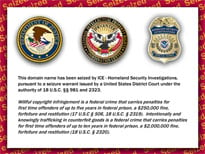 Over the past several months a series of domain name seizures by the Department of Justice (DOJ) and Immigration and Customs Enforcement (ICE) made headlines across the Internet.
Over the past several months a series of domain name seizures by the Department of Justice (DOJ) and Immigration and Customs Enforcement (ICE) made headlines across the Internet.
Under the flag of “Operation In Our Sites” the authorities shut down a dozen file-sharing and streaming sites, as well as close to 80 sites selling counterfeit goods. After two months of silence on the domain seizure front, the MPAA has now applauded the US authorities for their “successful” enforcement efforts.
“Operation In Our Sites has not only put illegal sites out of business, but has raised public awareness about this specific form of crime on the Internet. Most importantly, these enforcement efforts have resulted in most of these entities ceasing their illegal activity,” wrote the MPAA two days ago in a letter to the US Government.
In more ways than one, the above statement from the movie studios is a gross twist of reality. For one, the public awareness that was raised mostly concerned the realization that the Government was willing to sacrifice a lot, including first amendment rights, to protect the interests of the entertainment industries. The seizures resulted in heavy critique from journalists, legal experts, senators and most prominently, the public.
It is of course hardly a surprise that the MPAA is misrepresenting the truth in their favor, but adding that the domain seizures “resulted in most of these entities ceasing their illegal activity” goes too far. Let’s take a look at what really happened to the allegedly infringing file-sharing and streaming sites that had their domains seized, starting in reverse chronological order.
It wasn’t hard for the affected sites to continue their operations. Since their servers had not been touched physically it was a simple matter to change a few settings to make the sites available to the public again under a new domain, something achieved in a few minutes. This is exactly what most of the streaming and file-sharing related sites have done.
During the latest round of seizures under the “Operation In Our Sites” flag in February, a total of 10 domain names were targeted, belonging to 6 different sports streaming services. Despite the thousands of dollars in tax payer money that were spend on the enforcement effort, all of the sites were back up in no time under new domains.
As of today, only one of the six is no longer accessible and that is the site of Bryan McCarthy, who was arrested by the feds last month. McCarthy initially continued his Channelsurfing.net website under a new domain at Channelsurf.eu. The day after his arrest this site was still up and running and it is believed that due to the circumstances he took it offline himself after he was bailed out.
So, although all the sites noticed an initial dip in traffic due to the seizures, the actions of the US Government did little to actually stop the streaming services from operating. This was no different to the situation November last year when 82 domain names were seized. Although most of the targets were sites selling counterfeit goods, 4 file-sharing related domains were also seized, including Torrent-Finder.com.
As mentioned previously, the operator of Torrent-Finder immediately announced he would fight the seizure in court and continued operating under the Torrent-Finder.info domain. Of the three other ‘piracy’ related sites that were seized, two – OnSmash and Rapgodfathers – came back on another domain, carrying on where they left off. Again, the seizures appear to have had little effect.
If we look back at the first round of “Operation In Our Sites” seizures in June last year, a similar pattern emerges. Of the 8 movie streaming services that were targeted at least 3 have continued, and it wouldn’t be a big surprise if the smaller sites that didn’t return immediately started over under a new name.
The above clearly illustrates that a domain seizure is not the ultimate anti-piracy tool the authorities and the MPAA claim it is. Most of the piracy related sites simply continued under new domains, undeterred. This raises the question whether the costs involved warrant the mediocre outcome.
Aside from the tens of thousands of dollars in tax money being spent on the enforcement actions, the unconstitutionality of the seizures are also a cost that has to be factored in. And with the seizures failing to achieve the desired outcome, one has to question whether it’s all worth it.





